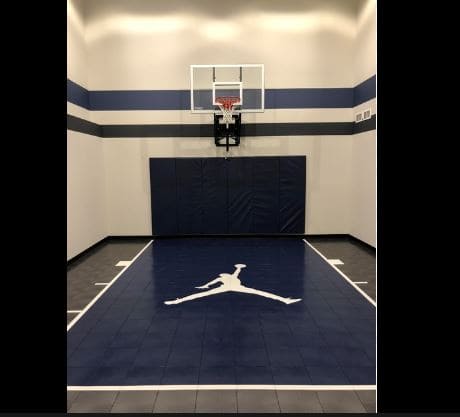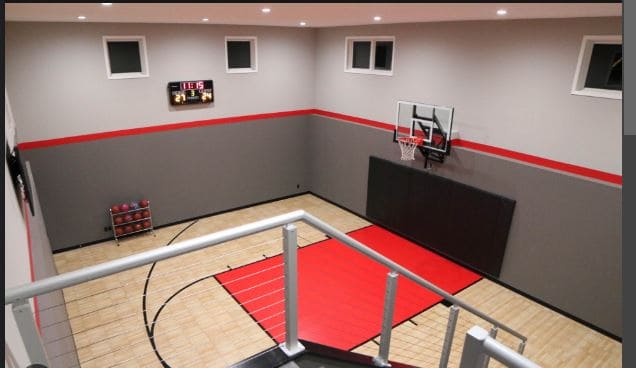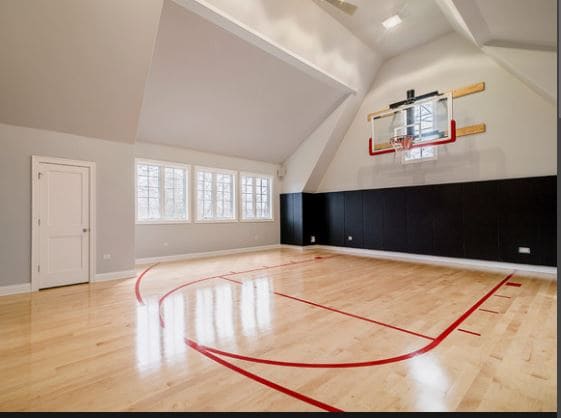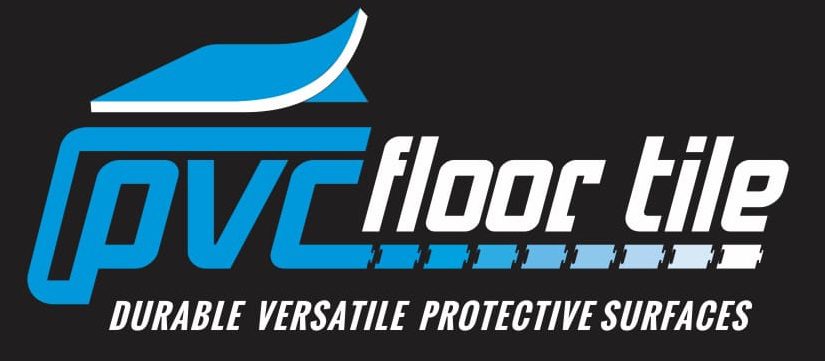
Top 5 Basketball Court Flooring Indoor Options
When it comes to creating the perfect basketball court flooring indoor, choosing the right flooring option is without a doubt one of the most crucial decisions.
The type of flooring can greatly impact the game, the players’ performance, and the overall experience. With various options available in the market, it can be overwhelming to decide.
In this article, we will explore the top 5 basketball court flooring options, their advantages, disadvantages, and help you make an informed choice.
Hardwood Flooring: Basketball Court Flooring Indoor
Hardwood flooring is the traditional and most popular choice for basketball courts. It offers a classic look, excellent ball bounce, and optimal performance. Hardwood floors are made from maple, which is known for its durability and ability to withstand heavy usage. They provide a smooth and consistent surface, allowing players to make swift moves and quick turns.
Advantages:
- Provides superior ball bounce and traction, enhancing player performance.
- Aesthetically pleasing and timeless appearance.
- Resistant to wear and tear, making it suitable for heavy usage.
- Easy to clean and maintain.
Disadvantages:
- High installation cost.
- Susceptible to water damage and moisture, requiring proper maintenance.
- Requires regular refinishing to maintain its appearance and performance.
Synthetic Flooring
Synthetic flooring is an increasingly popular option for basketball courts due to its versatility, durability, and cost-effectiveness. It is made from materials such as PVC, rubber, or polypropylene, and typically comes in interlocking tiles or rolls. Synthetic floors offer excellent shock absorption, reducing the risk of injuries and providing a comfortable playing surface.
Advantages:
- Budget-friendly option compared to hardwood flooring.
- Easy installation and maintenance.
- Durable and resistant to wear and tear.
- Can be customized with different designs, colours, and logos.
Disadvantages:
- Inferior ball bounce compared to hardwood flooring.
- Can be prone to scuffing and scratching.
- Some synthetic floors may emit a temporary odour after installation.
- Not as aesthetically pleasing as hardwood flooring.

Vinyl Flooring
Vinyl flooring has gained popularity in recent years due to its durability, affordability, and low maintenance requirements. It is made from a synthetic material called polyvinyl chloride (PVC) and offers a great combination of performance and aesthetics. Vinyl flooring is available in various thicknesses and can be customized with different colours and patterns.
Advantages:
- Provides good shock absorption and player comfort.
- Resistant to stains, spills, and moisture.
- Easy to clean and maintain.
- Versatile design options.
Disadvantages:
- Inferior ball bounce compared to hardwood flooring.
- Prone to scratches and scuff marks.
- Can be affected by extreme temperatures and UV exposure.
- Limited lifespan compared to hardwood flooring.
Rubber Flooring
Rubber flooring is a durable and resilient option for basketball courts, especially for outdoor or multi-purpose courts. It offers excellent shock absorption and provides a safe playing surface that minimizes the risk of injuries. Rubber floors come in the form of interlocking tiles or rolls and are available in different thicknesses and colours.
Advantages:
- Superior shock absorption and cushioning.
- Highly durable and resistant to heavy usage.
- Excellent traction and slip resistance.
- Easy installation and maintenance.
Disadvantages:
- Ball bounce may not be as consistent as hardwood flooring.
- Can emit an odour after installation, which dissipates over time.
- Not as aesthetically pleasing as hardwood or synthetic options.
- Susceptible to fading and discoloration over time.
Concrete Flooring
Concrete flooring is a practical and budget-friendly option for outdoor basketball courts or facilities with multi-purpose use. It offers a solid and stable surface, suitable for recreational play. While it may not provide the same level of performance as other options, concrete flooring can still be a viable choice for casual games or practice sessions.
Advantages:
- Cost-effective option.
- Resistant to wear and tear.
- Low maintenance requirements.
- Suitable for outdoor use.
Disadvantages:
- Poor shock absorption, increasing the risk of injuries.
- Lacks ball bounce compared to other options.
- Hard surface can cause impact-related discomfort.
- Limited versatility in terms of appearance and customization.

Essential characteristics of our floor tiles for sports:
- High grade Hexene LLDPE from SASOL an FDA Approved grade.
- Pvcocity Outdoor Sports tile dimensions 107 x 107 mm 14 mm thick
- Variety of colours
- Self-draining
- Custom sizes
- Low maintenance
- 100% recyclable materials
- UV 10-year warranty
- 5-year guarantee
- 20-year life expectancy
- Temperature restraint – 30 to 60 degrees Celsius
- 3-ton load tested CSIR
- Chemical resistant
Basketball Court Flooring Indoor vs. Outdoor Basketball Court Flooring
- Basketball Court Flooring Indoor is designed specifically for indoor use, while outdoor basketball court flooring is designed to withstand outdoor elements such as rain, sunlight, and temperature changes.
- Basketball Court Flooring Indoor is typically made from materials like hardwood, rubber, or synthetic materials that provide a smooth and consistent playing surface. Outdoor basketball court flooring is often made from asphalt, concrete, or acrylic surfaces that are more durable and can withstand heavy use and harsh weather conditions.
- Basketball Court Flooring Indoor offers better traction and grip, which is important for quick movements and preventing slips and falls. Outdoor basketball court flooring may be less grippy due to the rougher surface and exposure to various weather conditions.
- Basketball Court Flooring Indoor usually provides better ball bounce and consistent ball speed due to the quality of the surface. Outdoor basketball court flooring may have variations in ball bounce due to imperfections in the surface or weather-related factors like wind.
- Basketball Court Flooring Indoor offers a controlled environment that allows players to focus on their game without distractions from weather conditions or outdoor noise. Outdoor basketball court flooring may be noisier due to the surrounding environment, and players may have to adjust their gameplay based on wind and sunlight.
- Indoor basketball court flooring requires regular maintenance such as cleaning, refinishing, and occasional repainting to ensure optimal performance. Outdoor basketball court flooring may require more frequent maintenance due to its exposure to weather and natural elements.
- Basketball Court Flooring Indoor provides a more professional and polished appearance, making it suitable for professional or competitive games. Outdoor basketball court flooring may have a more casual or recreational look and may be more commonly found in public parks or community spaces.
- Basketball Court Flooring Indoor is typically found in gymnasiums, sports complexes, or private residences with dedicated indoor courts. Outdoor basketball court flooring is commonly found in public parks, schools, or outdoor sports facilities.
- Basketball Court Flooring Indoor may require a higher initial investment due to the higher quality materials and specialized installation. Outdoor basketball court flooring may be more cost-effective as it can be installed on existing surfaces like concrete or asphalt.
- The choice between indoor and outdoor basketball court flooring ultimately depends on the specific needs and preferences of the players and the intended use of the court. Indoor flooring may be preferred for professional and competitive games, while outdoor flooring may be more suitable for casual or recreational play.
Conclusion
Choosing the right basketball court flooring indoor is essential to ensure optimal performance, player safety, and longevity.
Hardwood flooring remains the gold standard, providing unparalleled performance and aesthetics. Consider the advantages and disadvantages of each option and select the one that best suits your requirements.
Remember, investing in high-quality basketball court flooring is a commitment to the game and the players who depend on a reliable surface to perform their best.

